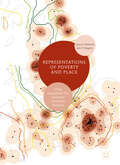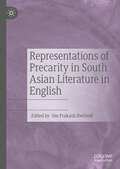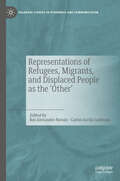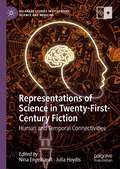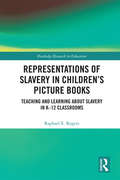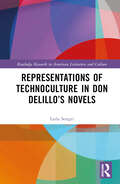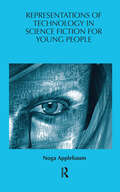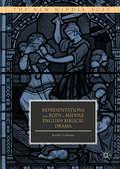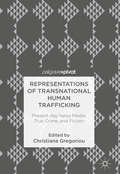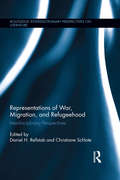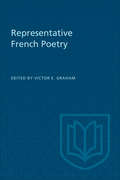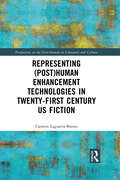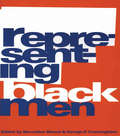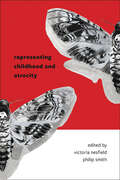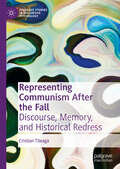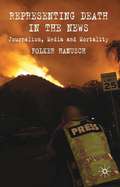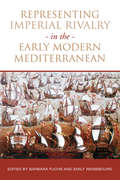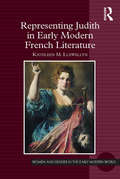- Table View
- List View
Representations of Loss in Irish Literature (New Directions in Irish and Irish American Literature)
by Deirdre Flynn Eugene O'BrienThis is the first book on Irish literature to focus on the theme of loss, and how it is represented in Irish writing. It focuses on how literature is ideally suited to expressions and understanding of the nature of loss, given its ability to access and express emotions, sensations, feelings, and the visceral and haptic areas of experience. Dealing with feelings and with sensations, poems, novels and drama can allow for cathartic expressions of these emotions, as well as for a fuller understanding of what is involved in loss across all situations. The main notion of loss being dealt with is that of death, but feelings of loss in the wake of immigration and of the loss of certainties that defined notions of identity are also analysed. This volume will be of interest to scholars, students and researchers in Irish Studies, loss, memory, trauma, death, and cultural studies.
Representations of Poverty and Place: Using Geographical Text Analysis To Understand Discourse
by Laura L Paterson Ian N GregoryThis book explores a novel methodological approach which combines analytical techniques from linguistics and geography to bring fresh insights to the study of poverty. Using Geographical Text Analysis, it maps the discursive construction of poverty in the UK and compares the results to what administrative data reveal. The analysis draws together qualitative and quantitative techniques from corpus linguistics, critical discourse analysis, Geographical Information Science, and the spatial humanities. By identifying the place-names that occur within close proximity to search terms associated with to poverty it shows how different newspapers use place to foreground different aspects of poverty (including employment, housing, money, and benefits), and how the London-centric nature of newspaper reporting dominates the discursive construction of UK poverty. This book demonstrates how interdisciplinary research methods can illuminate complex social issues and will appeal to researchers in a number of disciplines from sociology, geography and the spatial humanities, economics, linguistics, health, and public policy, in addition to policymakers and practitioners.
Representations of Precarity in South Asian Literature in English
by Om Prakash DwivediThis book analyzes precarious conditions and their manifestations in recent South Asian literature in English. Themes of disability, rural-urban division, caste, terrorism, poverty, gender, necropolitics, and uneven globalization are discussed in this book by established and emerging international scholars. Drawing their arguments from literary works rooted in the neoliberal period, the chapters show how the extractive ideology of neoliberalism invades the cultural, political, economic, and social spheres of postcolonial South Asia. The book explores different forms of “precarity” to investigate the vulnerable and insecure life conditions embodied in the everyday life of South Asia, enabling the reader to see through the rhetoric of “rising Asia”.
Representations of Refugees, Migrants, and Displaced People as the ‘Other’ (Palgrave Studies in Otherness and Communication)
by Rui Alexandre Novais Carlos Arcila CalderónThis book explores how 21st-century media-based discourses on migrants, refugees, and displaced people both reinforce and reconfigure existing negative stereotypes about these groups as 'other.' It is particularly pertinent considering the increasingly polarized world context and the evolving communication ecosystem with new media as privileged platforms for exclusionary narratives toward the ‘outgroups’ of migrants, refugees, and displaced people. The book's contributions encompass various methodologies and disciplines within communication studies, including qualitative analyses of media representations and quantitative research on public opinion. Unlike much of the existing English-language scholarship on these marginalized communities, this book de-centers North America and the UK to offer a global perspective focusing on regions such as continental and eastern Europe, the Middle East and Persian Gulf, India, China, Turkey, Russia, and Scandinavia.
Representations of Science in Twenty-First-Century Fiction: Human and Temporal Connectivities (Palgrave Studies in Literature, Science and Medicine)
by Nina Engelhardt Julia HoydisThis collection of essays explores current thematic and aesthetic directions in fictional science narratives in different genres, predominantly novels, but also poetry, film, and drama. The ten case studies, covering a range of British and American texts from the late twentieth to the twenty-first centuries, reflect the diversity of representations of science in contemporary fiction, including psychopharmacology and neuropathology, quantum physics and mathematics, biotechnology, genetics, and chemical weaponry. This collection considers how texts engage with science and technology to explore relations between bodies and minds, how such connectivities shape conceptions and narrations of the human, and how the speculative view of science fiction features alongside realist engagements with the Victorian period and modernism. Utilizing an interdisciplinary approach, contributors offer new insights into narrative engagement with science and its place in life today, in times past, and in times to come.
Representations of Slavery in Children’s Picture Books: Teaching and Learning about Slavery in K-12 Classrooms (Routledge Research in Education #21)
by Raphael E. RogersDrawing on critical race theory, critical race feminism, critical multicultural analysis, and intertextuality this book examines how slavery is represented in contemporary children’s picture books. Through analysis of recently published picture books about slavery, Rogers discusses how these books engage with and respond to the historiography of the institution of slavery. Exploring how contemporary writers and illustrators have represented the institution of slavery, Rogers presents a critical and responsible approach for reading and using picture books in K-12 classrooms and demonstrates how these picture books about slavery continue to perform important cultural work.
Representations of Technoculture in Don DeLillo’s Novels (Routledge Research in American Literature and Culture)
by Laila SougriThis book is the first to explore technoculture in all of Don DeLillo’s novels. From Americana (1971) to The Silence (2020), the American author anatomizes the constantly changing relationship between culture and technology in overt and layered aspects of the characters’ experiences. Through a tendency to discover and rediscover technocultural modes of appearance, DeLillo emphasizes settings wherein technological progress is implicated in cultural imperatives. This study brings forth representations of such implication/interaction through various themes, particularly perception, history, reality, space/architecture, information, and the posthuman. The chapters are based on a thematic structure that weaves DeLillo’s novels with the rich literary criticism produced on the author, and with the various theoretical frameworks of technoculture. This leads to the formulation and elaboration on numerous objects of research extracted from DeLillo's novels, namely: the theorization of DeLillo’s "radiance in dailiness," the investigation of various uses of technology as an extension, the role of image technologies in redefining history, the reconceptualization of the ethical and behavioral aspects of reality, the development of tele-visual and embodied perceptions in various technocultural spaces, and the involvement of information technologies in reconstructing the beliefs, behaviors, and activities of the posthuman. One of the main aims of the study is to show how DeLillo’s novels bring to light the constant transformation of technocultural everydayness. It is argued that though such transformation is confusing or resisted at times, it points to a transitional mode of being. This transitional state does not dehumanize DeLillo’s characters; it reveals their humanity in a continually changing world.
Representations of Technology in Science Fiction for Young People (Children's Literature and Culture)
by Noga ApplebaumIn this new book, Noga Applebaum surveys science fiction novels published for children and young adults from 1980 to the present, exposing the anti-technological bias existing within a genre often associated with the celebration of technology. Applebaum argues that perceptions of technology as a corrupting force, particularly in relation to its use by young people, are a manifestation of the enduring allure of the myth of childhood innocence and result in young-adult fiction that endorses a technophobic agenda. This agenda is a form of resistance to the changing face of childhood and technology’s contribution to this change. Further, Applebaum contends that technophobic literature disempowers its young readers by implying that the technologies of the future are inherently dangerous, while it neglects to acknowledge children’s complex, yet pleasurable, interactions with technology today. The study looks at works by well-known authors including M.T. Anderson, Monica Hughes, Lois Lowry, Garth Nix, and Philip Reeve, and explores topics such as ecology, cloning, the impact of technology on narrative structure, and the adult-child hierarchy. While focusing on the popular genre of science fiction as a useful case study, Applebaum demonstrates that negative attitudes toward technology exist within children’s literature in general, making the book of considerable interest to scholars of both science fiction and children’s literature.
Representations of the Body in Middle English Biblical Drama (The New Middle Ages)
by Estella CiobanuRepresentations of the Body in Middle English Biblical Drama combines epistemological enquiry, gender theory and Foucauldian concepts to investigate the body as a useful site for studying power, knowledge and truth. Intertwining the conceptualizations of violence and the performativity of gender identity and roles, Estella Ciobanu argues that studying violence in drama affords insights into the cultural and social aspects of the later Middle Ages. The text investigates these biblical plays through the perspective of the devil and offers a unique lens that exposes medieval disquiets about Christian teachings and the discourse of power. Through detailed primary source analysis and multidisciplinary scholarship, Ciobanu constructs a text that interrogates the significance of performance far beyond the stage.
Representations of the Moon in Literature and Art
by Gabriela Gândara TerenasThis book brings together a collection of essays on the occasion of the fiftieth anniversary of the arrival of the first man on the moon – a time when tourist journeys to the moon, now a real possibility, were no more than a fantasy. Divided into four sections, illustrating different perceptions of the moon, the common aim of the essays in this book is to examine how mankind’s interest in the moon has been represented in Literature and the Arts, an objective underpinned by the desire to exploit the relationship between the so-called two cultures—the Humanities and Science—as C.P. Snow perceived them in his pioneering work (1959). The plethora of ways in which our companion satellite has been portrayed has led the authors of the essays to draw upon research from the history of science as well as from literary, cultural and artistic studies. In addition to analysing the impact on literature and music, of our arrival on the moon, whether real or imaginary, these studies also examine how writers along the centuries have appropriated the moon as a metaphor in order to project latent conflict, criticise the society or politics of their day, reflect upon scientific or technological discoveries or fantasise about journeys, encounters or imaginary realities.
Representations of Transnational Human Trafficking: Present-day News Media, True Crime, and Fiction
by Christiana GregoriouThis open access edited collection examines representations of human trafficking in media ranging from British and Serbian newspapers, British and Scandinavian crime novels, and a documentary series, and questions the extent to which these portrayals reflect the realities of trafficking. It tackles the problematic tendency to under-report particular types of victim and forms of trafficking, and seeks to explore both dominant and marginalised points of view. The authors take a cross-disciplinary approach, utilising analytical tools from across the humanities and social sciences, including linguistics, literary and media studies, and cultural criminology. It will appeal to students, academics and policy-makers with an interest in human trafficking and its depiction in the modern day.
Representations of War, Migration, and Refugeehood: Interdisciplinary Perspectives (Routledge Interdisciplinary Perspectives on Literature)
by Daniel H. Rellstab Christiane SchloteWar, migration, and refugeehood are inextricably linked and the complex nature of all three phenomena offers profound opportunities for representation and misrepresentation. This volume brings together international contributors and practitioners from a wide range of fields, practices, and backgrounds to explore and problematize textual and visual inscriptions of war and migration in the arts, the media, and in academic, public, and political discourses. The essays in this collection address the academic and political interest in representations of the migrant and the refugee, and examine the constructed nature of categories and concepts such as ‘war,’ ‘refuge(e),’ ‘victim,’ ‘border,’ ‘home,’ ‘non-place,’ and ‘dis/location.’ Contributing authors engage with some of the most pressing questions surrounding war, migration, and refugeehood as well as with the ways in which war and its multifarious effects and repercussions in society are being framed, propagated, glorified, or contested. This volume initiates an interdisciplinary debate which re-evaluates the relationship between war, migration, and refugeehood and their representations.
Representative French Poetry (Second Edition)
by Victor E GrahamThe making of a reasonably comprehensive anthology which is intended to do more than reflect the personal literary tastes of the anthologists is not an easy task, but is certainly an exciting and challenging one. It is important, of course, if it is to have coherence and validity, that its audience be reasonably well defined and kept in mind as the selection proceeds. The anthology offered by Professor Graham has been prepared carefully to meet the needs of students reading French poetry while in the early years of their university course. It does not attempt to be a bulky sample of the whole field of French poetry but rather to be a judicious selection of the works of poets who may be described as typical of the best in their age. From each of them have been included some well-known selections which students must always meet and also some less well known which are nevertheless equal in quality and whose relative unfamiliarity may give them a special appeal to instructors. A particularly interesting and valuable feature of the anthology is that the editor has in a good many cases chosen poems on similar themes from different authors, and students will thus be able to compare styles of different centuries and different poets as applied to certain specific subjects. (For example, the selection includes Deschamps' "Balade" on "Renart et le Corbaut" and La Fontaine's "Le Corbeau et le Renard'; Lamartine's and also Leconte de Lisle's "Le Lac.")
Representing (Perspectives on the Non-Human in Literature and Culture)
by Carmen Laguarta-BuenoThis work studies three twenty-first century novels by Richard Powers, Dave Eggers and Don DeLillo as representative of a new trend of US fiction concerned with the topic of the technological augmentation of the human condition. The different chapters provide, from the double perspective of the optimistic transhumanist philosophy and the more balanced approach of critical posthumanism, an overview of the narrative strategies used by the writers to explore the possibilities that biotechnology, digital technologies and cryonics open up to transcend our human limitations, while also warning their readers of their most nefarious consequences. Ultimately, the book puts forward the claim that even if the writers approach the subject from a variety of perspectives and using different narrative styles and techniques, they all share a critical posthumanist fear that an unrestrained and unquestioned use of technology for enhancement purposes may bring about disembodiment and dehumanization.
Representing (Perspectives on the Non-Human in Literature and Culture)
by Carmen Laguarta-BuenoThis work studies three twenty-first century novels by Richard Powers, Dave Eggers and Don DeLillo as representative of a new trend of US fiction concerned with the topic of the technological augmentation of the human condition. The different chapters provide, from the double perspective of the optimistic transhumanist philosophy and the more balanced approach of critical posthumanism, an overview of the narrative strategies used by the writers to explore the possibilities that biotechnology, digital technologies and cryonics open up to transcend our human limitations, while also warning their readers of their most nefarious consequences. Ultimately, the book puts forward the claim that even if the writers approach the subject from a variety of perspectives and using different narrative styles and techniques, they all share a critical posthumanist fear that an unrestrained and unquestioned use of technology for enhancement purposes may bring about disembodiment and dehumanization.
Representing Africa in Children's Literature: Old and New Ways of Seeing (Children's Literature and Culture)
by Vivian Yenika-AgbawRepresenting Africa in Children’s Literature explores how African and Western authors portray youth in contemporary African societies, critically examining the dominant images of Africa and Africans in books published between 1960 and 2005. The book focuses on contemporary children’s and young adult literature set in Africa, examining issues regarding colonialism, the politics of representation, and the challenges posed to both "insiders" and "outsiders" writing about Africa for children.
Representing Black Girl Magic with Contemporary Picture Books
by Raphael E. RogersRepresenting Black Girl Magic with Contemporary Picture Books explores how contemporary, culturally relevant, and responsive picture books can provide educators with a chance to teach about race and racism in the classroom. A wave of recently published picture books by Black women authors have pushed back against negative beliefs, countered negative stereotypes, and celebrated the joy and magic of Black girls and their families. Featuring the voices and perspectives of over two dozen Black women writers, in this book, Raphael Rogers examines how and why these publications are changing the picture book and the educational landscape.With sections on classroom connections and discussion questions in every chapter, this book is ideal for courses on teaching children’s literature and diversity in children’s literature.
Representing Black Men
by Marcellus Blount George P. CunninghamRepresenting Black Men focuses on gender, race and representation in the literary and cultural work of black men.
Representing Childhood and Atrocity: Representing Childhood And Atrocity
by Victoria Nesfield; Philip SmithAtrocity presents a problem to the writer of children's literature. To represent events of such terrible magnitude and impersonal will as the Holocaust, the transatlantic slave trade, or the Rwandan genocide such that they fit into a three-act structure with a comprehensible moral and a happy ending is to do a disservice to the victims. Yet to confront children with the fact of widescale violence without resolution is to confront them with realities that may be emotionally disturbing and even damaging. Despite these challenges, however, there exists a considerable body of work for and about children that addresses atrocity. To examine the ways in which writers and artists have attempted to address children's experience of atrocity, this collection brings together original essays by an international group of scholars working in the fields of child studies, children's literature, comics studies, education, English literature, and Holocaust, genocide, and memory studies. It covers a broad geographical range and includes works by established authors and emerging voices.
Representing Children in Chinese and U.S. Children's Literature (Studies in Childhood, 1700 to the Present)
by Rebecca Morris Claudia NelsonBringing together children’s literature scholars from China and the United States, this collection provides an introduction to the scope and goals of a field characterized by active but also distinctive scholarship in two countries with very different rhetorical traditions. The volume’s five sections highlight the differences between and overlapping concerns of Chinese and American scholars, as they examine children’s literature with respect to cultural metaphors and motifs, historical movements, authorship, didacticism, important themes, and the current status of and future directions for literature and criticism. Wide-ranging and admirably ambitious in its encouragement of communication between scholars from two major nations, Representing Children in Chinese and U.S. Children’s Literature serves as a model for examining how and why children’s literature, more than many literary forms, circulates internationally.
Representing Communism After the Fall: Discourse, Memory, and Historical Redress (Palgrave Studies in Discursive Psychology)
by Cristian TileagăThis book explores the contribution of discursive psychology and discourse analysis to researching the relationship between history and collective memory. Analysing significant manifestations of the moral vocabulary of the Romanian transition from communism to democracy, the author demonstrates how discursive psychology can be used to understand some of the enduring and persistent dilemmas around the legacy of communism. This book argues that an understanding of language as an action-oriented, world-building resource can fill an important gap in the theorizing of public controversies over individual and collective meaning of the recent (communist) past. The author posits that discursive social psychology can serve as an intellectual and empirical bridge that can overcome several of the difficulties faced by researchers working in transitional justice studies and cognate fields. This reflective book will appeal to students and scholars of transitional justice, discursive psychology, memory studies, and the sociology of change.
Representing Death in the News
by Folker HanuschThis new study maps and synthesizes existing research on the ways in which journalism deals with death. Folker Hanusch provides a historical overview of death in the news, looks at the conditions of production, content and reception, and also analyzes emerging trends in the representation of death online.
Representing Female Artistic Labour, 1848–1890: Refining Work for the Middle-Class Woman
by Patricia ZakreskiPatricia Zakreski's interdisciplinary study draws on fiction, prose, painting, and the periodical press to expand and redefine our understanding of women's relationship to paid work during the Victorian period. While the idea of 'separate spheres' has largely gone uncontested by feminist critics studying female labour during the nineteenth century, Zakreski challenges this distinction by showing that the divisions between public and private were, in fact, surprisingly flexible, with homes described as workplaces and workplaces as homes. By combining art with forms of industrial or mass production in representations of the respectable woman worker, writers projected a form of paid creative work that was not violated or profaned by the public world of the market in which it was traded. Looking specifically at sewing, art, writing, and acting, Zakreski shows how these professions increasingly came to be defined as 'artistic' and thus as suitable professions for middle-class women, and argues that the supposedly degrading activity of paid work could be transformed into a refining experience for women. Rather than consigning working women to the margins of patriarchal culture, then, her study shows how representations of creative women, by authors such as Elizabeth Barrett Browning, Dinah Craik, Charles Dickens, Anthony Trollope, and Charlotte Yonge, participated in and shaped new forms of mainstream culture.
Representing Imperial Rivalry in the Early Modern Mediterranean
by Emily Weissbourd Barbara FuchsRepresenting Imperial Rivalry in the Early Modern Mediterranean explores representations of national, racial, and religious identities within a region dominated by the clash of empires. Bringing together studies of English, Spanish, Italian, and Ottoman literature and cultural artifacts, the volume moves from the broadest issues of representation in the Mediterranean to a case study - early modern England - where the "Mediterranean turn" has radically changed the field.The essays in this wide-ranging literary and cultural study examine the rhetoric which surrounds imperial competition in this era, ranging from poems commemorating the battle of Lepanto to elaborately adorned maps of contested frontiers. They will be of interest to scholars in fields such as history, comparative literary studies, and religious studies.
Representing Judith in Early Modern French Literature (Women And Gender In The Early Modern World Ser.)
by Kathleen M. LlewellynAlthough attention to the Book of Judith and its heroine has grown in recent years, this is the first full-length study to focus on adaptations of the Bible’s Old Testament Book of Judith across a range of literary genres written in French during the early modern era. Author Kathleen Llewellyn bases her analysis on references to Judith in a number of early modern sermons as well as the ’Judith’ texts of four early modern writers. The texts include two theatrical dramas, Le Mystère de Judith et Holofernés (c. 1500), believed to have been written by Jean Molinet, and Le Miroir des vefves: Tragédie sacrée d'Holoferne & Judith by Pierre Heyns (1596), as well as two epic poems, La Judit (1574) by Guillaume de Salluste Du Bartas, and Gabrielle de Coignard’s Imitation de la victoire de Judich (1594). Llewellyn’s goal is to see Judith as she was envisioned by early modern French writers and their readers, and to understand how the sixteenth century shaped their view of the heroine. Noting aspects of that story that were emphasized by sixteenth-century authors, as well as elements that those writers altered to suit their purposes, she also examines the ways in which writers of this era made use of Judith’s story as a means to explore interests and concerns of early modern writers, readers, and spectators. Representing Judith in Early Modern French Literature provides a deeper understanding of early modern ideas regarding the role of women, the use of exemplary stories in preaching and teaching, theories of vision, and the importance of community in Renaissance France.

